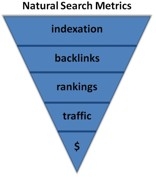Measuring success in search engine optimization can typically be done in four ways. “Indexation” measurements will determine if a search engine has properly identified all of your site’s pages. “Backlink” measurements will show the number of internal and external links that point to your site as a whole. “Rankings” measurements will show where in the natural search results your site appears for given search words or phrases. And “traffic and revenue” measurements will show the keywords used to find your site, revenue generated per keyword, the percentage of visitors that purchased products and so forth.
 This article will explore each of the measurements, which we refer to here as “metrics.”
This article will explore each of the measurements, which we refer to here as “metrics.”
Indexation Metrics
Indexation is the first critical step to natural search performance. Pages that aren’t indexed have zero chance of ranking in the search engines. However, more indexation isn’t necessarily better because that could indicate that identical pages in your site are duplicated in a search engine’s index, which will decrease a site’s ability to rank because the pages are, essentially, competing against themselves.
What is the “right” indexation number? Most ecommerce sites can only guesstimate based on the number of products they offer. For example, if a site offers 50,000 products but only has 5,000 pages indexed, there’s likely a barrier preventing a search engine from fully “crawling” a site. Conversely, if that same site has 500,000 pages indexed, there’s likely a duplication issue. The site will then have issues with self-competition and split-link popularity, both of which hinder a site’s ability to rank strongly.
Indexation is measured by performing a “site:” query in the major engines. For example, type [site:www.yourdomain.com] into the Google and MSN Live search boxes, without the [brackets]. For Yahoo!, just enter the URL into Yahoo! Site Explorer. These site queries measure how many URLs are indexed in each engine. Compare that number to the number of pages that should exist to determine actions required and progress made.
A complete list of the queries available in Google, some of which are also available on Yahoo! and MSN Live, can be found at http://www.google.com/help/cheatsheet.html.
Backlink Metrics
Measuring “backlinks” will show the number of links pointing to various pages across a site. Generally, the more external links that point to your site, the higher your site will rank in natural search results. However, measuring backlinks varies among the search engines.
For Google, enter a “link:” query such as [link:www.yourdomain.com] in the search box. This is a measure of how many backlinks are coming into the entire domain. However, Google only gives the true measure of backlinks in its Webmaster Tools, which anyone can access once they have a Google account.
For Yahoo!, enter the domain into Yahoo! Site Explorer. Click on the “InLinks” tab and filter the results to show four different data sets: (1) all backlinks (internal & external), (2) only external backlinks, (3) only to the home page and (4) to the whole site.
For MSN, the “link:” query is currently disabled in MSN Live, so backlinks cannot be measured there.
How many backlinks should a site have? There is no way to estimate in the way we can for indexation, and the engines aren’t known for giving accurate, specific or detailed backlink data, unfortunately. The best advice for measuring backlinks is to watch the trend rather than be concerned about individual numbers. And more high quality links are always better.
Advanced Link Manager is a tool for scanning and reporting on backlink trends, including number and diversity of domains linking in, anchor text diversity, and a number of other reports.
Ranking Metrics
Rankings are a tricky metric to report on. Rankings (i.e. where your site appears in natural search listings) vary greatly between singular and plural versions of the same term. Moreover, personalized and blended search affect individual rankings so that no two people are likely to get the same ranking result. However, I suggest a couple of ways to attack this issue.
- Targeted. Choose a select set of keyword terms that you’ll target based on keyword research. These will probably include the trophy terms for which management aspires to rank. Use a subscription rank checker such as WebCEO or a free tool such as the Rank Checker plug in for Firefox to check the rankings for the terms you’re targeting. These tools will give you only the rankings for the terms you specify, for the domains you specify.
- Aggregate. Subscription tools like Enquisite offer the ability to track the page on which a term ranks for every keyword that drives natural search to your site. So, say that [widgets] drove 10 visits to mydomain.com. Enquisite would report which URLs on my site drove those 10 visits, and what page in the search results the rankings were on. The information can be sliced and sorted by keyword, URL, IP, date, engine, and more.
Traffic and Revenue Metrics
Natural search-referred traffic is a common measurement in most analytics programs. The “holy grail” for measuring SEO effectiveness is frequently a report combining URL, keyword, traffic, orders, and revenue. Such a report tells you which URLs are effective, and by omission, which are not. It tells you which keywords and keyword phrases drive traffic, and by omission which don’t. And it tells you which URLs and terms drive sales through natural search and which don’t.
Consider which pages were optimized and how, for which keywords. Those pages and keywords are the ones where you should expect to see growth. Only by performing large-scale programmatic optimizations, like title tags across the entire site, would you expect to see a site-wide increase in traffic. Most optimization efforts will improve performance for individual pages and keywords. Knowing which pages and keywords are most valuable to your business will guide those optimization efforts.




